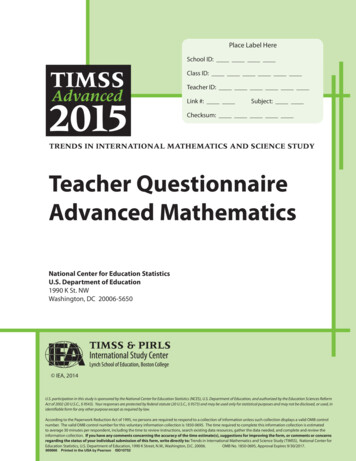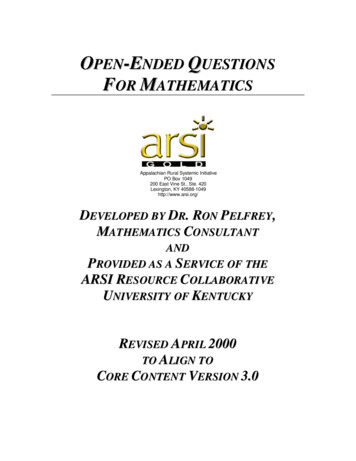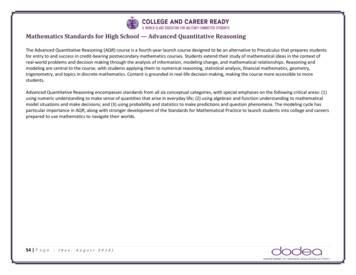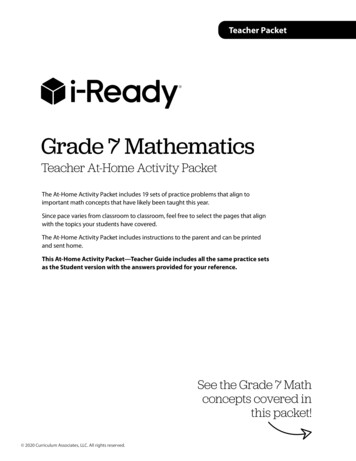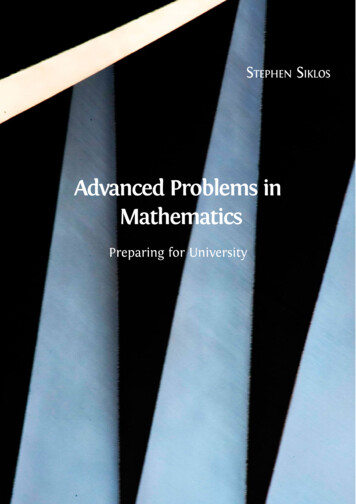
Transcription
Stephen SiklosAdvanced Problems inMathematicsPreparing for University
ADVANCED PROBLEMS INMATHEMATICS
Advanced Problems in Mathematics:Preparing for UniversityStephen Siklos
http://www.openbookpublishers.comc 2016 Stephen Siklos.⃝This work is licensed under a Creative Commons Attribution 4.0 International license (CC BY 4.0). Thislicense allows you to share, copy, distribute and transmit the work; to adapt the work and to makecommercial use of the work providing attribution is made to the author (but not in any way that suggeststhat they endorse you or your use of the work). Attribution should include the following information:Stephen Siklos, Advanced Problems in Mathematics: Preparing for University. Cambridge, UK: Open BookPublishers, 2015. http://dx.doi.org/ 10.11647/OBP.0075Further details about CC BY licenses are available at http://creativecommons.org/licenses/by/4.0/Digital material and resources associated with this volume are available 1427STEP questions reproduced by kind permission of Cambridge Assessment Group Archives.This is the first volume of the OBP Series in Mathematics:ISSN 2397-1126 (Print)ISSN 2397-1134 (Online)ISBN Paperback: 9781783741427ISBN Digital (PDF): 9781783741441ISBN Digital ebook (epub): 9781783741458ISBN Digital ebook (mobi): 9781783741465DOI: 10.11647/OBP.0075c Diane Potter. Creative Commons AttributionCover image: Paternoster Vents (2012). Photograph ⃝NonCommercial-NoDerivs CC BY-NC-NDAll paper used by Open Book Publishers is SFI (Sustainable Forestry Initiative) and PEFC (Programmefor the Endorsement of Forest Certification Schemes) Certified.Printed in the United Kingdom and United States byLightning Source for Open Book Publishers
ContentsAbout this bookixSTEP1Worked Problems11Worked problem 111Worked problem 215Problems19P1 An integer equation19P2 Partitions of 10 and 2021P3 Mathematical deduction23P4 Divisibility25P5 The modulus function27P6 The regular Reuleaux heptagon29P7 Chain of equations31P8 Trig. equations33P9 Integration by substitution35P10 True or false37P11 Egyptian fractions39P12 Maximising with constraints41P13 Binomial expansion43P14 Sketching subsets of the plane45P15 More sketching subsets of the plane47P16 Non-linear simultaneous equations49P17 Inequalities51P18 Inequalities from cubics53P19 Logarithms55P20 Cosmological models57P21 Melting snowballs59P22 Gregory’s series61P23 Intersection of ellipses63P24 Sketching x (1 x)65mn
vi Advanced Problems in MathematicsP25 Inequalities by area estimates67P26 Simultaneous integral equations69P27 Relation between coefficients of quartic for real roots71P28 Fermat numbers73P29 Telescoping series75P30 Integer solutions of cubics77P31 The harmonic series79P32 Integration by substitution81P33 More curve sketching83P34 Trig sum85P35 Roots of a cubic equation88P36 Root counting90P37 Irrationality of e92P38 Discontinuous integrands94P39 A difficult integral96P40 Estimating the value of an integral98P41 Integrating the modulus function100P42 Geometry102P43 The t substitution104P44 A differential-difference equation106P45 Lagrange’s identity108P46 Bernoulli polynomials110P47 Vector geometry112P48 Solving a quartic114P49 Areas and volumes116P50 More curve sketching118P51 Spherical loaf120P52 Snowploughing122P53 Tortoise and hare124P54 How did the chicken cross the road?126P55 Hank’s gold mine128P56 A chocolate orange130P57 Lorry on bend132P58 Fielding134P59 Equilibrium of rod of non-uniform density136P60 Newton’s cradle138P61 Kinematics of rotating target140P62 Particle on wedge142P63 Sphere on step144
Stephen Siklos viiP64 Elastic band on cylinder146P65 A knock-out tournament148P66 Harry the calculating horse150P67 PIN guessing152P68 Breaking plates154P69 Lottery156P70 Bodies in the fridge158P71 Choosing keys160P72 Commuting by train162P73 Collecting voles164P74 Breaking a stick166P75 Random quadratics168Syllabus170
About this bookThis book has two aims. The general aim is to help bridge the gap between school and university mathematics.You might wonder why such a gap exists. The reason is that mathematics is taught at school forvarious purposes: to improve numeracy; to hone problem-solving skills; as a service for studentsgoing on to study subjects that require some mathematical skills (economics, biology, engineering,chemistry — the list is long); and, finally, to provide a foundation for the small number of studentswho will continue to a specialist mathematics degree. It is a very rare school that can achieveall this, and almost inevitably the course is least successful for its smallest constituency, the realmathematicians. The more specific aim is to help you to prepare for STEP or other examinations required for university entrance in mathematics. To find out more about STEP, read the next section.It used to be said that mathematics and cricket were not spectator sports; and this is still true of mathematics. To progress as a mathematician, you have to strengthen your mathematical muscles. It is notenough just to read books or attend lectures. You have to work on problems yourself.One way of achieving the first of the aims set out above is to work on the second, and that is how thisbook is structured. It consists almost entirely of problems for you to work on.The problems are all based on STEP questions. I chose the questions either because they are ‘nice’ —in the sense that you should get a lot of pleasure from tackling them (I did), or because I felt I hadsomething interesting to say about them.The first two problems (the ‘worked problems’) are in a stream of consciousness format. They are intended to give you an idea how a trained mathematician would think when tackling them. This approach is much too long-winded to sustain for the remainder of the book, but it should help you to seewhat sort of questions you should be asking yourself as you work on the later problems.Each subsequent problem occupies two pages. On the first page is the STEP question, followed by acomment. The comments may contain hints, they may direct your attention to key points, and they mayinclude more general discussions. On the next page is a solution; you have to turn over, so that your eyecannot accidentally fall on a key line of working. The solutions give enough working for you to be ableto read them through and pick up at least the gist of the method; they may not give all the details of thecalculations. For each problem, the given solution is of course just one way of producing the requiredresult: there may be many other equally good or better ways. Finally, if there is space on the page afterthe solution (which is sometimes not the case, especially if diagrams have to be fitted in), there is apostmortem. The postmortems may indicate what aspects of the solution you should be reviewing andthey may tell you about the ideas behind the problems.I hope that you will use the comments and solutions as springboards rather than feather beds. You willonly really benefit from this book if you have a good go at each problem before looking at the commentand certainly before looking at the solution. The problems are chosen so that there is something foryou to learn from each one, and this will be lost to you for ever if you simply read the solution withoutthinking about the problem on your own.
x Advanced Problems in MathematicsI have given each problem a difficulty rating ranging from to . Difficulty in mathematics is in theeye of the beholder: you might find a question difficult simply because you overlooked some key step,which on another day you would not have hesitated over. You should not therefore be discouraged ifyou are stuck on a -question; though you should probably be encouraged if you get through one ofthe rare -questions without mishap.This book is about depth not breadth. I have not tried to teach you any new topics. Instead, I wantto lead you towards a deeper understanding of the material you already know. I therefore restrictedmyself to problems requiring knowledge of the specific and rather limited syllabus that is laid out at theend of the book. The pure mathematics section corresponds to the syllabus for STEP papers I and II. Ifyou are studying British A-levels, Scottish Highers, or the International Baccalaureate, for example, youwill be familiar with most of this material. For the mechanics and statistics/probability sections, thereis less agreement about what a core syllabus should be (in the IB there is no mechanics at all), so I gavemyself a freer hand.Calculators are not required for any of the problems in this book and calculators are not permitted inSTEP examinations. In the early days of STEP, calculators were permitted but they were not required forany question. It was found that candidates who tried to use calculators sometimes ended up missingthe point of the question or getting a silly answer. My advice is to remove the battery so that you are nottempted.I started this section by listing the aims of the book. You may have noticed that teaching you mathematics is not an aim. I can’t remember where I heard the following rather nice analogy. In 1464, a huge blockof Carrara marble was carefully chosen from a quarry in Tuscany and transported to Florence, where itlay almost untouched for many years. In 1501 it was given to the sculptor Michelangelo. He workedhard on it, chipping away and chipping away for three years, until at last, inside the block, he found abeautiful statue of David. You can see a picture s/michelangelos-david/And the analogy? I can’t teach you mathematics with this book, but I believe that much hard work onyour part, chipping away at the problems, will eventually reveal the mathematician that is within you.I hope you enjoy using this book as much as I have enjoyed putting it together.
STEPWhat is STEP?STEP (Sixth Term Examination Paper) is an examination used by Cambridge University as part of itsprocedure for admitting students to study mathematics. Applicants are interviewed in December, andmay then be offered a place conditional on the results of their public examinations (A-level, InternationalBaccalaureate, etc) and STEP. The examinations are sat in June and offers are confirmed in August whenall the examination results are available.STEP is used for conditional offers not just by Cambridge, but (at the time of writing) also by WarwickUniversity for almost all of its Mathematics offers, and to a lesser extent by some other English universities. Many other university mathematics departments recommend that their applicants practise on thepast papers even if they do not take the examination. In 2015, 4322 scripts were marked, only about1000 of which were written by students holding an offer from Cambridge.The first STEPs were taken in 1987, and there was were specimen papers before that from which someof the questions in this book were drawn. At that time, there were STEPs in many subjects but by 2001only the mathematics papers remained. The examination has been more or less stable over nearly 30years: it has not been blown about by the various fads in the public examinations systems that cameand went during that time.There are three STEPs, called papers I, II and III. Each paper has thirteen questions, including three onmechanics and two on probability/statistics. Candidates are assessed on six questions only.The pure mathematics question in Papers I and II are based the core A-level Mathematics syllabus, withsome minor additions, which is listed at the end of this book. The pure mathematics questions in PaperIII are based on a ‘typical’ Further Mathematics mathematics A-level syllabus (at the time of writing,there is not even a partial core for Further Mathematics A-levels).There is also no core (at the time of writing) for A-level mechanics and statistics, so the STEP syllabusesfor these areas consist of material that a student with a particular interest might have covered. It has tobe said, though, that the statistics questions are very likely to require knowledge of probability ratherthan statistics (for example, there are very few questions on statistical tests of given data). This is becausethe underlying theory of statistics is quite difficult, and therefore unsuitable for examining at this level,whereas the application of statistical tests is rather routine and again unsuitable for examination at thislevel.What is the purpose of STEP?From the point of view of admissions to a university mathematics course, STEP has three purposes. It is used as a hurdle for entrance to university mathematics courses, and sometimes for othermathematics-based courses. There is strong evidence that success in STEP correlates very well
2 Advanced Problems in Mathematicswith university examination results.1 It acts as preparation for the university course, because the style of mathematics found in STEPquestions is similar to that of undergraduate mathematics. It tests motivation. It is important to prepare for STEP (by working through old papers, for example), which can require considerable dedication. Those who are not willing to make the effort areunlikely to thrive on a difficult university mathematics course.STEP vs A-levelA-level2 tests mathematical knowledge and technique by asking you to tackle fairly stereotyped problems. STEP asks you to apply the same knowledge and technique to problems that are, ideally, unfamiliar.Here is an A-level question, in which you follow the instructions in the question:By using the substitution u 2x 1, or otherwise, find 2xdx.(2x 1)2And here, for comparison, is a STEP question, which requires both competence in basic mathematicaltechniques and mathematical intuition. Note that help is given for the first integral, so that everyonestarts at the same level. Then, for the second integral, candidates have to show that they understandwhy the substitution used in the first part worked, and how it can be adapted.Use the substitution x 2 cos θ to evaluate the integral 23/2Show that, for a b, qp(x ab x(x 13 x)12dx )12dx. (b a)(π 3 3 6),12where p (3a b)/4 and q (a b)/2.The differences between STEP and A-level are:1.STEP questions are much longer. Candidates completing four questions in three hours will almostcertainly get a grade 1.2.STEP questions are much less routine.3.STEP questions may require considerable dexterity in performing mathematical manipulations.4.Individual STEP questions may require knowledge of several different areas of mathematics (especially the mechanics and statistics questions, which will often require advanced pure mathematicaltechniques).1Recent studies comparing rank in STEP with rank in first-year Cambridge mathematics examinations reveal a Spearman correlation coefficient of 0.63, which is very high in comparison with other predictors of university examination results.2I use the term ‘A-level’ here as a shorthand for a typical school mathematics examination. The particular examinations you takemay well be very different in style and format but, even if that is the case, I am sure some of what follows will strike a chordwith you.
Stephen Siklos 35.The marks available for each part of the question are not disclosed on the paper.6.There is a lot of choice on STEP papers (6 questions out of 13).7.Calculators are not permitted in STEP examinations.These difference matter, because in mathematics more than in any other subject it is very important tomatch the difficulty of the question with the ability of the candidates. For example, you could reasonablyhave the question ‘Was Henry VIII a good king?’ on a lower-school history paper, an A-level paper, or asa PhD topic. The answers would (or should) differ according to the level. On mathematics examinationpapers, the question has to be tailored to the level in order to discriminate between the candidates: if itis too easy, nearly all candidates will score very high marks; if it is too hard, nearly all candidates willmake little progress on any of the questions.Setting STEPSTEP is produced under the auspices of the Cambridge Assessment examining board. The setting procedure starts 30 months before the date of the examination, when the three examiners (one for each paper,from schools or universities) are asked to produce a draft paper. The first drafts are then vetted by theSTEP coordinator (me!), who tries to enforce uniformity of difficulty, checks suitability of material andstyle, and tries to reduce overlap between the papers. Examiners then produce a second draft, based onthe coordinator’s suggestions. The second drafts are agreed with the coordinator and then circulatedto three moderators (normally school teachers), and to the other examiners, who produce written comments and discuss the drafts in a two-day meeting. The examiners then produce third drafts, taking intoaccount the consensus at the meetings. These drafts are sent to a vetter, who works through the papers,pointing out mistakes and infelicities. The resulting draft is checked by a second vetter and finally bya team of students. At each stage, the drafts are produced camera-ready, using a special mathematicalword-processing package called LaTeX (which is also used to typeset this book).3STEP QuestionsSTEP questions do not fall into any one category. Typically, there will be a range of types on each of thepapers. Here are some thoughts, in no particular order. My favourite sort of question is in two (or maybe more) parts: in the first part, candidates areasked to perform some unfamiliar task and are told how to do it (integration using a given substitution, or expressing a quartic as the algebraic sum of two squares, for example); for the later parts,candidates are expected to demonstrate that they have understood and learned from the first partby applying the method to a new and perhaps more complicated task. Another favourite of mine is the question which has different answers according to the value of acertain number (or parameter). A common example involves sketching a graph whose shape depends on whether a parameter is positive or negative. Ideally, the different values of the parameterare not given in the question, and candidate has to identify them for herself or himself.3It is freely available, so you might like to try it out. You will probably find it good fun to use, but quite time-consuming and notreally suitable for writing out the solutions of STEP problems.
4 Advanced Problems in Mathematics Another good type of question requires candidates to do some preliminary special-case work andthen prove a general result. In another type, candidates have to show that they can understand and use new notation or a newtheorem. Questions with several unrelated parts (for example, three integrals using different techniques)are generally avoided; but if they occur, there tends to be a ‘sting in the tail’ involving putting allthe parts together in some way. Some questions do not rely on any part of the syllabus: instead they might require ‘common sense’,involving counting or seeing patterns, or they might involve some aspect of more elementarymathematics with an unusual slant. Such questions try to test capacity for clear and logical thoughtwithout using much mathematical knowledge (like the calendar question mentioned in the sectionon preparation below, or questions concerning islands populated by toads ‘who always tell thetruth’ and frogs ‘who always fib’). Some questions are devised to check that you do not simply apply routine methods blindly. Forexample, a function might have a maximum value at the end of the interval upon which it isdefined, even though its derivative might be non-zero there. Finding the maximum in such a caseis not simply a question of routine differentiation. There are always questions specifically on integration or differentiation, and many others (including mechanics and probability) that use calculus as a means to an end. Graph-sketching is regarded by mathematicians as a fundamental skill and there are nearly alwaysquestions that require a sketch. Basic ideas from analysis, such as b0 f (x) k 0 f (x)dx (b a)kaorf ′ (x) 0 f (b) f (a) for b aor the relationship between an integral and a sum often come up, though knowledge of suchresults is never assumed — candidates may be told that they can use the result without proof, or asketch ‘proof’ may be asked for. As mentioned above, questions on statistical tests are rare, because questions that require realunderstanding (rather than ‘cookbook’ methods) tend to be too difficult. More often, the questionsin the Probability and Statistics section are about probability. The mechanics questions normally require a firm understanding of the basic principles (when toapply conservation of momentum and energy, for example) and may well involve a differentialequation. Projectile questions are often set, but are never routine.Advice to candidatesFirst appearancesI am often asked whether STEP is ‘difficult’. Of course, it depends on what is meant by ‘difficult’; it isnot difficult compared with the mathematics I do every day. But to be on the safe side, I always answer‘yes’ before explaining further.
Stephen Siklos 5Your first impression on looking at a STEP paper is likely to be that it does indeed look very difficult.Don’t be discouraged! Its difficult appearance is largely due to it being very different in style from whatyou are used to.At the time of writing, a typical A-level examination lasts 90 minutes and contains 10 compulsory questions. That is 9 minutes per question. If you are considering studying mathematics at a top university, itis likely that you will manage to do them all and get them nearly all right in the time available. A STEPexamination lasts 3 hours, and you are only supposed to do six questions in three hours. You are verylikely to get a grade 1 if you manage four questions (not necessarily complete); that means that eachquestion is designed to take 45 minutes. If you compare a 9 minute question with a 45 minute question,of course the 45 minute question looks very hard!You may be put off by the number of subjects covered on the paper. You should not be. STEP is supposed to provide sufficient questions for all candidates, no matter which mathematics syllabus (at theappropriate level) they have covered. It would be a very exceptional candidate who had the knowledgerequired to do all the questions. And there is plenty of choice (6 questions out of 13).Once you get used to the idea that STEP is very different from A-level, it becomes much less daunting.PreparationThe best preparation for STEP (apart, of course, from working through this excellent book) is to workslowly through old papers.4 Hints and answers are available for some years, but you should use thesewith discretion: doing a question with hints and answers in front of you is nothing like doing it yourself,and you may well miss the whole point of the question (which is to make you think about mathematics).In general, thinking about the problem is much more important than getting the answer.Should you try to learn up areas of mathematics that are not in your syllabus in preparation for STEP?The important thing to know is that it is much better to be very good at your syllabus than to have havea sketchy knowledge of lots of additional topics: depth rather than breadth is what matters. It mayconceivably be worth your while to round out your knowledge of a topic you have already studied tofit in with the STEP syllabus; it is probably not worth your while to learn a new topic for the purposesof the exam, though I can think of a couple of exceptions: Hyperbolic functions obey simple rules similar to trigonometric functions (in fact, they are thesame functions in the complex plane). If you haven’t come across them, you can easily masterthem in a short time and this will open the door to many questions that would otherwise havebeen inaccessible to you. de Moivre’s theorem (relating to complex numbers) is also very straightforward, though questionsrequiring de Moivre are less common.It is worth emphasising that there is no ‘hidden agenda’: a candidate who does two complete probabilityquestions and two complete mechanics questions will obtain the same mark and grade as one who doesfour complete pure questions.Just as the examiners have no hidden agenda concerning syllabus, so they have no hidden agendaconcerning your method of answering the question. If you can get to the end of a question correctly you4These and the other publications mentioned below are obtainable from the STEP web site www.stepmathematics.org.uk. Youwill also find other useful material on the NRICH web site; do google it now if you haven’t already done so.
6 Advanced Problems in Mathematicswill get full marks whatever method you use.5 Some years ago one of the questions asked candidatesto find the day of the week of a given date (say, the 5th of June 1905). A candidate who simply countedbackwards day by day from the date of the exam would have received full marks for that question (butwould not have had time to do any other questions).You may be worried that the examiners expect some mysterious thing called rigour. Do not worry: STEPis an exam for schools, not universities, and the examiners understand the difference. Nevertheless, it isextremely important that you present ideas clearly, and show working at all stages.PresentationYou should set out your answer legibly and logically (don’t scribble down the first thought that comesinto your head) – this not only helps you to avoid silly mistakes but also signals to the examiner thatyou know what you are doing (which can be effective even if you haven’t the foggiest idea what youare doing).Examiners are not as concerned with neatness as you might fear. However if you receive complaintsfrom your teachers that your answers are difficult to follow then you should listen.6 Remember thatmore space usually means greater legibility. Try writing on alternate lines (this leaves a blank line forcorrections).Try to read your answers with a hostile eye. Have you made it clear when you have come to the endof a particular argument? Try underlining your conclusions. Have you explained what you are tryingto do? For example, if a question asks ‘Is A true?’ try beginning your answer by writing ‘A is true’ —if you think that it is true — so that the examiner knows which way your argument leads. If you usedsome idea (for example, integration by substitution), did you tell the examiner that this is what youwere doing?What to do if you cannot get started on a problemTry the following, in order. Reread the question to check that you understand what is wanted. Reread the question to look for clues – the way it is phrased, or the way a formula is written,or other relevant parts of the question. (You may think that the setters are trying to set difficultquestions or to catch you out. Usually, nothing could be further from the truth: they are probablydoing all in their power to make it easy for you by trying to tell you what to do). Try to work out exactly what it is that you don’t understand. Simplify the notation – e.g. by writing out sums explicitly. Look at special cases (choose special values which simplify the problem) in order to try to understand why a result is true. Write down your thoughts – in particular, try to express the exact reason why you are stuck.5Though you must obey instructions in the question: for example, if it says ‘Hence prove .’, then you must use the previousresult in your proof.6Begin rant: I am very surprised at the scrappy and illegible work that I receive from a few of my students. It seems so disrespectful to expect me to spend ages trying to decipher their work when they could have spent a little more time making itpresentable, for example by copying it out neatly or writing more slowly. Why is my time less important than theirs? End rant.
Stephen Siklos 7 Go on to another question and go back later. If you are preparing for the examination (but not in the actual examination!) take a short break.7 Discuss it with a friend or teacher (again, better not do this in the actual examination) or consultthe hints and answers, but make sure you still think it through yourself.BUT REMEMBER: following someone else’s solution is not remotely the same thing as doing theproblem yourself. Once you have seen someone else’s solution to a problem, then you are deprived, for ever, of much of the benefit that could have come from working it out yourself.Even if, ultimately, you get stuck on a particular problem, you derive vastly more benefit fromseeing a solution to something with which you have already struggled, than by simply followinga solution to something to which you’ve given very little thought.What if a problem isn’t coming out?If you have got started but the answer doesn’t seem to be coming out, then try the following. Check your algebra. In particular, make sure that what you have written works in special cases.For example: if you have written the series for log(1 x) as1 x 12 x2 13 x3 · · ·then a quick check will reveal that it doesn’t work for x 0; clearly, the 1 should not be there.8A note on the subject of algebra. In many of the problems in this book, the algebra is quite stiff:you have to go through many lines of calculation before you get to an expression recognisablyclose to your target. Really, the only way to manage this efficiently is to check each line carefullybefore going on the next line. Otherwise, you can waste hours.9 Make sure that what you have written makes sense. For example, in a problem which is dimensionally consistent, you cannot add x (with dimension length, say) to x2 or to exp x (which itselfdoes not make sense — the argument of exp has to be dimen
x Advanced Problems in Mathematics I have given each problem a difficulty rating ranging from to . Difficulty in mathematics is in the eye of the beholder: you might find a question difficult simply because you overlooked some key step,
